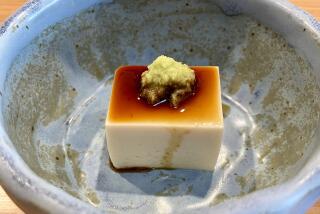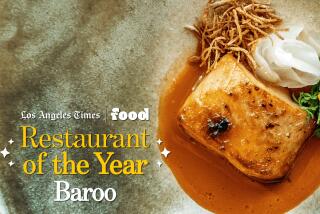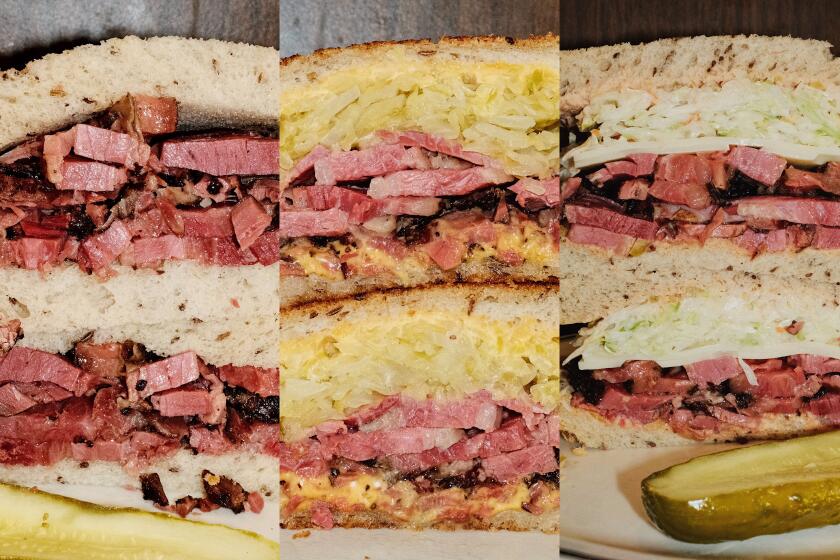Nozawa Land keeps growing; what it means for L.A. sushi

When I first went to Sushi Nozawa near the end of 1987, I was mostly impressed with its rigor. The fish was good enough, the usual parade of tuna, yellowtail and mackerel, but there was a sign that read, “Today’s special: Trust me,” and the chef, Kazunori Nozawa, made it clear that you were expected to eat what you were served in the order you were served it. I had barely sat down at the empty sushi bar before I was informed that no spicy tuna rolls would be served, only barbarians rubbed their chopsticks together to rid them of splinters and that wasabi was not to be mixed into the soy sauce but applied sparingly to the fish as a condiment.
“One bite only, please!” he barked when I lifted the first piece of fish.
I ate the halibut in a single bite, registering its softness, the warmth of the rice and the musk of minced herbs. He was correct. I began to think of the restaurant as a graduate school of fish.
At the time, omakase, the trust-me school of service, was an option you could exercise at sushi bars where you were a regular, where the chef had registered your preferences for silvery fish, slightly smaller piers of rice or a light touch with ponzu. The relationship with a favorite sushi chef is an intimate, ongoing dialogue. There was also a scattering of chefs who would refuse to serve you anything that hadn’t existed in Edo-era Japan.
Sushi Nozawa was the first restaurant here to combine the strict mandates of the traditionalists with the institution of omakase. And, although Nozawa was neither the finest nor the most innovative sushi chef even in Studio City, his insistence on what amounted to set meals let him keep his prices down, and his mania for high-quality fish let his customers experience something close to the rhythms of a first-class sushi experience without having to cultivate a relationship with a sushi chef or speaking a word of Japanese.
Nozawa’s restaurant became extremely popular, attracting fanatical regulars from the entertainment-industry complexes in the neighborhood, and became perhaps most famous for his proclivity for banning patrons who refused to follow his rules, including Charlize Theron. Legions of Los Angeles sushi chefs came through his ranks, including those who went on to open such places as Sasabune, Go’s Mart, Echigo, Sushi Zo and Hiko — each of them perpetuating Nozawa’s aesthetic. If you are handed a crab hand roll as a final course at a sushi bar, you are experiencing the School of Nozawa. If your cucumber roll contains nothing but slivered cucumber and a couple of sesame seeds or your first course is a cereal bowl of tuna nuta, diced tuna dressed with a stingingly tart ponzu sauce, that’s Nozawa too.
In Sushi Nozawa’s last few years, the experience became rote: assembly-line sushi dealt out like blackjack hands on faded plastic plates. I was assuming that the chef had lost the will to cook. What I hadn’t expected is that he was more or less using his restaurant as a lab, reducing the luxury sushi experience to its essentials. And by the time he closed Sushi Nozawa a couple of years ago, he had already moved on to the next phase: Sugarfish, where the sushi chefs worked in a hidden rear kitchen and the omakase had been reduced to Trust Me, Trust Me Lite and Nozawa Trust Me, a fixed-price procession of edamame, sashimi and sushi rolled out like the set dinners at Norm’s.
To a huge number of people in Los Angeles, Sugarfish is sushi: sleekly lit dining rooms, drinkable cold sake and sushi immediately recognizable as Nozawa-style: warm, loosely packed rice; soft fish; crisp seaweed; and minimal garnish. The wasabi is presented in soft, pale-green mounds that resemble tiny puffs of meringue. The wait for a table can be endless, but if you time it right you can be in and out in 20 minutes. Nobody lectures you about how to eat your fish. You start with steamed edamame, go on to tuna nuta and finish with a crab hand roll.
I have been to three outlets of Sugarfish in the last week, in Marina del Rey, downtown and tucked into the original Sushi Nozawa location in Studio City, and as far as I can tell the only difference between them is the occasional availability of ankimo downtown. (A waitress in the Marina spoke of that monkfish liver mousse longingly, like an Abercrombie & Fitch salesperson talking about a line of T-shirts available only in New York.)
There is also the ultra-high-end Nozawa Bar, hidden in the back of the Beverly Hills Sugarfish, past the kitchen and through a door marked Staff Only. The 10 seats are overseen by Osamu Fujita, a longtime friend of Nozawa who was well known as a hotel sushi chef (his specialties included a Midori-flavored tuna cocktail served over dry ice), but he too has converted to the gospel of warm rice and crisp seaweed.
You are eating jellyfish in ponzu instead of tuna cubes at Nozawa Bar, and you experience things like tiny Japanese shrimp, live surf clam, whole Santa Barbara abalone and Japanese sawara along the way, but the experience is also from Nozawa World: warm, crisp sushi rolls stuffed with chopped lobster or minced tuna belly; halibut sushi with peppery yuzu kosho; oysters. Everybody is served the same course at the same time. Everybody is charmed by Fujita, who manages to counsel the serious sushi-philes and joke with the 20th anniversary couples while slapping Santa Barbara uni onto his hot rice. Everybody pays — Fujita’s omakase costs five times that of the basic omakase in the next room.
So are Nozawa Bar’s Hokkaido scallops sweeter, the toro better-aged, the lobster more carefully cooked than their equivalents at the restaurant that surrounds it? Wouldn’t you rather be seasoning your food with fresh wasabi? Of course. It needs to be. But the miracle is that the experiences are so close to each other that one seems to feed the other.
Which brings us, I guess, to downtown’s Kazu Nori, the newest citizen of Nozawa Land, which serves basically only rolls: toro rolls, blue crab rolls, yellowtail rolls, lobster rolls and salmon rolls: crisp seaweed, warm rice and the same seafood slurries you know from Sugarfish. The quality of the rolls may be even better than at Sugarfish — they are handed to you by the guy who makes them, and you are instructed to eat them immediately.
You would be ecstatic to eat Kazu Nori rolls in any airport or shopping mall in the country. You are happy enough to grab a couple before a night of cocktails at the nearby Varnish or a concert at Disney Hall.
Follow me on Twitter @thejgold
Kazu Nori
Sushi in the age of mechanical reproduction.
LOCATION
421 S. Main St., Los Angeles, (213) 493-6956, www.kazunorisushi.com
PRICES
Set menus, $10.50-$17.50, plus 16% service charge
DETAILS
Open 11:30 a.m. to 11 p.m. Mondays to Thursdays, 11:30 a.m. to midnight Fridays and Saturdays, noon to 10 p.m. Sundays. Credit cards accepted. Beer, wine and sake. Street parking.
RECOMMENDED DISH
Hand rolls.
ALSO:
Nozawa Bar, 212 N. Cañon Drive, Beverly Hills, (424) 216-6158, www.nozawabar.com. Set menu, $150, plus 16% service charge. Dinner seatings Mondays to Saturdays; reservations mandatory. Credit cards accepted. Beer, wine and sake. Valet parking.
Sugarfish, various locations, sugarfishsushi.com. Set dinner menus, $20-$40. Open 11:30 a.m. to 10 p.m. Mondays to Saturdays, noon to 9 p.m. Sundays. Credit cards accepted. Beer, wine and sake. No reservations.
More to Read
Eat your way across L.A.
Get our weekly Tasting Notes newsletter for reviews, news and more.
You may occasionally receive promotional content from the Los Angeles Times.











